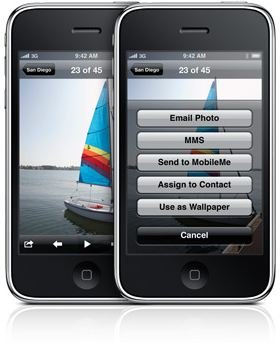Is the iPhone 3G S the End of the Compact Digital Camera?
The New iPhone 3G S Camera
It is no secret that the built-in cameras on cell phones have become extremely popular, some manufacturers putting cameras up to 5MP on their phones. We have entered an age of photography in which excellent, crisp photos can be taken with devices that are half the size of a dollar bill. Digital photography is increasingly becoming more integrated with the ubiquitous sharing that so many of us engage in. From Myspace to Facebook, Flicker to Twitter, many have confirmed that they like sharing what they’ve made, shot, done, or heard with. . . well, anyone who cares to listen.
The new iPhone 3G S takes cell phone photography to a whole new level. Featuring a modest 3MP camera, this phone features state-of-the-art technology. One of the most impressive features is the new tap autofocus, pictured to the left. There’s no scrolling or buttons to change autofocus like on regular digital cameras. You simply tap on the part of the image that you want to be in focus, and the iPhone auto-configures the settings to take the shot. With this, you can get an increased depth of field and the exposure automatically adjusts to make the focused item properly exposed.
The word on the blogs and forums is that this new “tap autofocus” technology may become standard on all digital cameras sometime in the near future, including on D-SLRs. Think about it - Apple doesn’t even make cameras! But somehow they were able to think of and develop this feature that virtually everyone loves and that could become the norm on all cameras.
Sharing Photos

The ability to share photos with friends and others is very important and a new staple of digital photographers, both professional and amateur alike. This is where cell phone camera technology has a huge advantage over traditional cameras. With a digital camera, the best you can do is take the photo, download it to a computer, find an internet connection, go to a website, and upload the photo. With a cell phone, it can be as easy as taking the photo, clicking a button, and then uploading the photo to your favorite photo sharing website. With new cell phones with advanced camera technology, more people are choosing them over traditional cameras because they have instant connection to the internet anywhere.
When I was in Hawaii on my honeymoon, I was able to instantaneously send my family photos of the beaches and sunsets from my iPhone. With the new iPhone 3G S, the photos would have been even more crisp. Also, since the new iPhone supports MMS, users will soon be able to send them like text messages to others. iPhone owners can send photos right from the camera application to their MobileMe accounts, through email, to the wallpaper, or assign it to a contact. With endless apps from the App Store, users can upload their photos to their favorite sites like Flicker and Facebook. With ever-increasing 3G speeds and availability as well as the onset of 4G technology, sharing of multimedia photos and videos will continue to increase.
Conclusion
Most compact digital cameras cost between $100-200, which is what the iPhone 3G and iPhone 3G S cost. Why carry a separate device around for photos when the iPhone can do everything that the compact cameras can? In time, I hope that Apple will provide more manual control over exposure, depth of field, white balance, etc., but the auto settings aren’t bad at all. Is this the end of the compact digital camera? We shall see.
Image Credit
All images Copyright © Apple. www.apple.com.
